Archive for April 2018
You’re Invited to an Evening of Celebration and Determination
Click Here for Tickets and Sponsorship
Joppa is one of Dallas’ most intact Freedman’s Township. One of only three left. It was founded by slaves liberated from the near-by Miller plantation on the banks of the Trinity River. Descendants of those slaves still own homes in Joppa.
But over the last century it’s been surrounded by heavy industry and tons of air 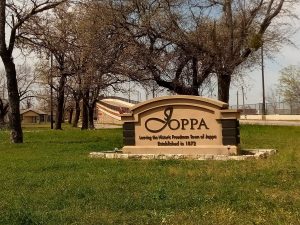 pollution. EPA’s nearest air monitor is nine miles away.
pollution. EPA’s nearest air monitor is nine miles away.
In March, the Joppa Freedman’s Township Association defeated a proposal to locate two additional concrete batch plants there when it came before the Dallas City Council. A week before the vote Downwinders at Risk board members used their new portable particulate matter monitors to show how high current high pollution levels already are.
Despite the community’s longtime pollution burden, it was the first time any actual air monitoring in the had actually been done there.
Now, the JFTA and Downwinders have agreed to partner in an unprecedented and historic way to try to redress decades of environmental racism by working for the creation of a”Joppa Environmental Preservation District.”
This new district would have special zoning and land use policies dedicated to reducing the amount of pollution Joppa residents are subjected to on a daily basis – all designed to “Let Joppa Breathe.”
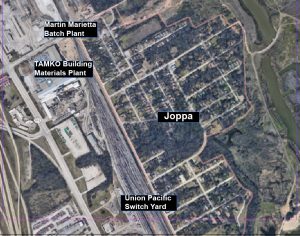 As a first step, we want this Environmental Preservation District to have more extensive air quality monitoring, especially for Particulate Matter.
As a first step, we want this Environmental Preservation District to have more extensive air quality monitoring, especially for Particulate Matter.
And to do that by this summer, we need your support on May 22nd.
That evening JFTA and Downwinders are hosting a benefit to raise money to buy multiple air quality monitors for the community.
Thanks to your generosity and the Dallas Sierra Club, we already have enough for one, but we need more – at least one on each side of the community and more if we can get them.
We want Joppa to be an example of the kind of dense monitoring we want to bring to all of DFW in the years ahead.
A $25 ticket gets you food, wine or beer, and a program highlighting the cultural and historical significance of Joppa as well as celebrating our determined effort to preserve and revitalize it.
Not only will we be unveiling more details about our plans on May 22, you’ll also be treated to a line-up of great entertainment, beginning with MC duties being performed by Dallas spoken word artist and poet Rage Almighty.
Come out on May 22nd to support a good cause, eat good food, and watch an inspiring program that will leave you fired-up and ready to go.
Click Here for Tickets and Sponsorship
Alternative Earth Day Event

THANKS TO YOUR GENEROSITY JOPPA FUNDRAISING IS A SUCCESS
Thanks to Downwinders supporters and the Dallas Sierra Club that pitched in a whopping $1000,  we raised the $1600 needed to buy Joppa residents their own full time Aeroqual Particulate Matter monitor. Now comes the hard part in deciding where to put it.
we raised the $1600 needed to buy Joppa residents their own full time Aeroqual Particulate Matter monitor. Now comes the hard part in deciding where to put it.
Downwinders and Joppa residents are schedule to meet to discuss the location of the monitor and the protocol surrounding the data gathering.
Unlike the monitors being proposed as the backbone of the new regional network, the Aeroqual model doesn’t connect to the Internet as it collects its data in real time. It’s readings have to be downloaded and examined offline.
There’s also the issue of whether to leave the monitor in one place or move it around the 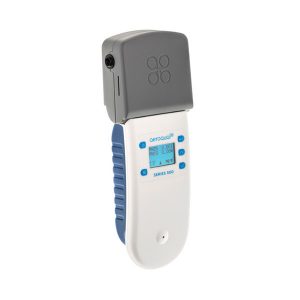 neighborhood to test where those new internet-connected network monitors might go when they get here.
neighborhood to test where those new internet-connected network monitors might go when they get here.
Nevertheless, the placement of a calibrated PM monitor taking readings 24/7 is a huge advance in public health self-protection for Joppa. And this is just the first step in what we hope will be on on-going effort to redress Joppa’s history of environmental racism.
Thanks to everyone who contributed to the effort. We’ll keep you updated.
This Year @EDX: Stop By and See Our Wall of PM Video Art

Downwinders is very lucky to have Dallas media lab The Virtual Wild and its artist-owner artist Jay Rutherford creating a special video display of the data we’ve collected with our new portable PM monitors for this year’s Earth Day X @Fair Park. Using a large 72- inch video monitor as his palette, Jay is painting with light and code to produce a really memorable exhibition. His mission: to make air pollution more interesting and show it new contexts and perspectives. This year we’ll be side-by-side with our partners at the DFW Air Research Consortium. UTD scientists and others will be showing off their own monitor hardware and Downwinders will have its portable monitors to demonstrate as well. Come by and enjoy Jay’s handiwork and stick around to look at the equipment that’s changing the way public health is protected in North Texas. |
How To Build an Air Monitoring Network….for Joppa and the Rest of DFW
HOW TO TURN THIS:
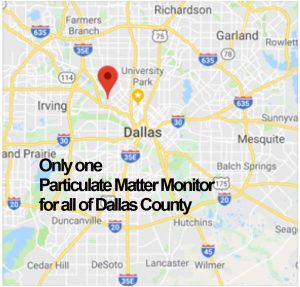
INTO THIS:
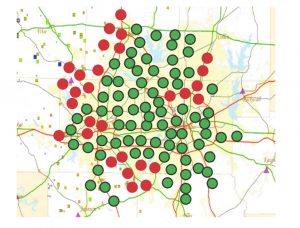
Dallas County finalizes documents for founding a regional air quality monitoring network among local governments – will your city, county, school or hospital district vote to join?
In the same week that Downwinders at Risk and the Dallas Sierra Club raised enough money to buy a full-time stationary Particulate Matter monitor for the distressed Joppa community, Dallas County Commissioner Theresa Daniel announced she was sending out documents vetted by the Dallas County District Attorney’s office for the founding of a region-wide air monitoring network to be administered by local governments.
With a working title of “The North Texas Clean Air Network,” the documents propose an Inter-Local Agreement between area municipalities, counties, school and hospital districts to oversee a system of inter-connected particulate matter monitors that insures scientific credibility, uniformity, transparency, and accountability through administration of an appointed board of member representatives.
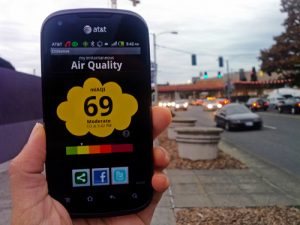 This kind of air monitoring network is vastly superior in terms of time and space to what exists now. Instead of only a few monitors for seven million DFW residents spread out over an area the size of a New England state, it would contain hundreds of locations – none further than a block or two away from where ever you are. And instead of waiting for a reading of what the air was like one or two hours previously, these networks can deliver the information in constantly updating five-second intervals, in real time.
This kind of air monitoring network is vastly superior in terms of time and space to what exists now. Instead of only a few monitors for seven million DFW residents spread out over an area the size of a New England state, it would contain hundreds of locations – none further than a block or two away from where ever you are. And instead of waiting for a reading of what the air was like one or two hours previously, these networks can deliver the information in constantly updating five-second intervals, in real time.
The result is a bonanza of data for public health administrators, school officials and urban planners, as well as a new “smart” tool for residents to use in their everyday lives. Planning a run or a walk? Chart the least polluted path. Trying to minimize air pollution from congestion? Tweak the synchronization of your stoplights until you find the timing that produces the least emissions. Track classroom absentee rates to pollution levels and enforce schools’ no idling zones. High-tech low-cost air quality monitoring is one of the most useful applications of emerging smart cities technology.
Air quality monitoring’s potential is recognized in Dallas’ “smart cities”planning chart, placing it under both “Public Health and Safety” and “Equity and Empowerment.” The recent fight over new batch plants in the Joppa’s community and the part Downwinders’ portable monitors played in it shows air monitoring is a powerful new high tech tool for citizens.
Language in the County’s documents initially includes only Dallas County, City of Dallas and City of Plano since those were the three entities represented when informal discussions began last summer, BUT ALL DFW LOCAL GOVERNMENTS ARE INVITED TO JOIN. Reportedly the documents have already been sent to both Dallas and Plano city halls for consideration and action. In Dallas, it’s expected longtime clean air advocate Council Member Sandy Greyson’s Quality of Life Committee will host a hearing on the proposal in the near future.
Given recent events in Joppa, Council Member Kevin Felder is also presumed to be a part of the effort to get Dallas’ to join.
Dense air monitoring networks are being rolled out in many other American and foreign metropolitan areas. Baltimore has proposed a 500-monitor network, Chicago at least as many. Chattanooga has its first ten being built and installed – by a laboratory at the University of Texas at Dallas.
Even though it’s had decades of air pollution problems, DFW has been slow to catch-up with this trend. The North Texas Clean Air Network would begin to address that lag with a first wave of 24 to 50 donated monitors…from that same UTD lab, where Dr. David Lary, one of the world’s leading authority on environmental sensor technologies, teaches physics.
Dr. Lary’s research was just advanced by a large Department of Defense grant to test small high-tech air monitors under a variety of environmental contaminants for possible deployment in the field. This grant and others is allowing UTD to turn its Physics Department into an air monitoring assembly line benefiting the entire region. That’s why the costs of buying and installing the first wave of DFW air monitors is so cheap.
It’s also a reason the public can trust he information they’re getting from the Network as well. Thanks to researchers at the University of North Texas Health Science Center, we know DFW residents are more likely to believe independent third party data about air quality than information they get from government sources.
The documents created by Dallas County are only the first step. Like everything else concerning environmental protection, this monitoring network is a Do-It-Yourself campaign.
ALL THREE NORTH TEXAS CLEAN AIR NETWORK DOCUMENTS TO SHARE WITH YOUR LOCAL CITY COUNCIL, COUNTY COMMISSIONERS COURT, SCHOOL OR HOSPITAL BOARD:
By-laws [pdf-embedder url=”https://www.downwindersatrisk.org/wp-content/uploads/2018/04/North-Texas-Clean-Air-Network-Bylaws-5-2.pdf” title=”North-Texas-Clean-Air-Network-Bylaws-5 2″]
Articles of Incorporation [pdf-embedder url=”https://www.downwindersatrisk.org/wp-content/uploads/2018/04/Articles-of-Incorporation-for-North-Texas-Clean-Air-Network0D0A-5.pdf” title=”Articles of Incorporation for North Texas Clean Air Network 5″]
Interlocal Agreement [pdf-embedder url=”https://www.downwindersatrisk.org/wp-content/uploads/2018/04/North-Texas-Clean-Air-Interlocal-Agreement-5.pdf” title=”North Texas Clean Air Interlocal Agreement 5″]
AIR MONITORING Q&A
What is the Mission of The North Texas Clean Air Network?
1. Provide the best, most up-to-date factual information about local air quality by supervising the implementation and maintenance of a publicly accessible, secure, and scientifically credible regional air sensor network providing simultaneous real time air quality information from multiple locations within member or contracted jurisdictions via the World Wide Web.
2. Provide fact-based public education resources on local air quality.
3. Support scientific research on local air quality by local colleges, universities, hospitals and schools.
4. Work with regulatory agencies and entities to further local clean air goals.
How much would it cost cities and counties to join the Sensor Network?
Nothing. Joining is free, and even the first 25-50 monitors are being donated by UTD and other researchers. Only small electrical and internet connectivity costs for each monitorwill be incurred.
Who will be on the Network’s Board?
1. Sitting Dallas City Council Member
2. Dallas Office of Environmental Quality representative
3. City of Dallas Public Advocate representative
4. Sitting Dallas Commissioners Court member
5. Parkland Health and Hospital representative
6. Dallas County Public Advocate representative
7. Dallas County Medical Society representative
8. Siting City of Plano Council Member
9. Plano Sustainability & Environmental Education Division representative
10. Plano Public Advocate representative
11. Dallas Independent School District representative
(Your Local Government Representative Here When They Join)
How will expansion and operating costs of the Network be paid for?
For the first year, the initial wave of air monitors isb eing donated. Future monitors and maintenance will be paid for by adoption of Network installation and connection fees, grants donations., and directed funding from local governments.
Who will be the Network’s technical supervisor?
Dr. David Lary, UTD Physics Department.
$75,000 to Midlothian ISD Special Needs is Final Act of Clean Air Fund
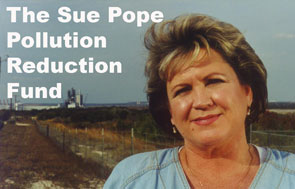 Sue Pope just said no.
Sue Pope just said no.
No to Holcim Cement Inc. No to the EPA. No to the State of Texas.
In 2000, despite intense pressure, the Midlothian rancher would not agree to allow the company’s local cement plant to double its capacity without a public hearing. When her objections were overruled and the plant became a huge source of illegal new pollution, her stubbornness was finally rewarded.
Not only did the company have to install new pollution controls; not only did it have to pay for a staff scientist for Pope and her group, Downwinders at Risk, to use for unscheduled plant inspections at Holcim. It also had to put aside $2.3 million dollars for new clean air projects in DFW.
12 years and dozens of grants later, that $2.3 million has all been spent – on things like hybrid school buses and delivery trucks, solar panels in South Dallas, energy efficiency projects in Fort Worth, public transit in Arlington and electric lawnmower trade-ins.
The only thing left to do to close out the largest and most successful endowment of its type in the state history is disburse the interest accumulated over the life of the Sue Pope Pollution Reduction Fund. That will happen today when, according to the specific wishes of Pope herself, $75,000 will be donated to the Special Needs education program in the Midlothian public schools. It’s believed to be the largest single donation to the MISD from a local resident.
“The reason I got involved in clean air issues was because of the children,” said Pope. “In the 1980’s, I began to hear of so many Midlothian area children with rare diseases and birth defects like Down Syndrome and Autism. When we started connecting these problems with local industry, I decided that something needed to be done about it.”
In a ceremony at the L. A. Mills Administration Building 100 Walter Stephenson Road scheduled for 4:45 Monday, Pope will present the check to the Midlothian School Board, some members of which were still in public school themselves when she began her crusade for clean air in the 1980’s.
Whether or not they acknowledge Pope’s original motivation, the Board is reportedly happy to accept the money that one woman’s stubbornness and – thoughtfulness – has brought them.


